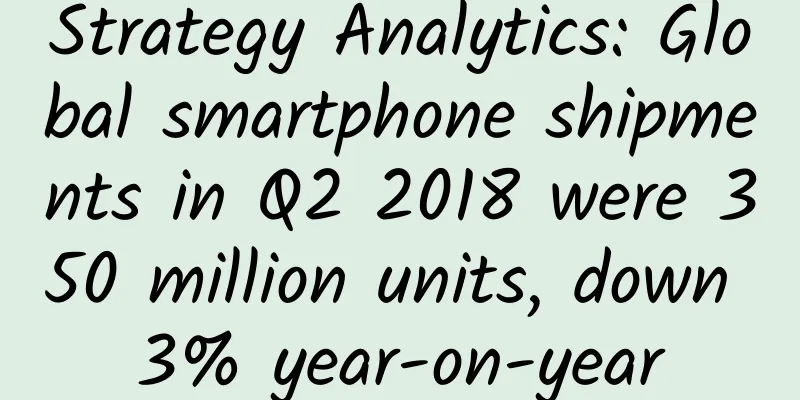Strategy Analytics: Global smartphone shipments in Q2 2018 were 350 million units, down 3% year-on-year

|
Strategy Analytics ' latest research report points out that global smartphone shipments fell 3 % year-on-year to 350 million units in Q2 2018. Samsung maintained its first place with a 20 % global smartphone market share, while Huawei surpassed Apple for the first time in history to become the world's second largest smartphone manufacturer. “Global smartphone shipments fell 3% year-on-year from 360.4 million units in Q2 2017 to 350.4 million units in Q2 2018,” said Qian Sui, Director at Strategy Analytics. “The global smartphone market has slowed down this year due to longer replacement cycles, reduced operator subsidies, and a lack of new hardware design innovations.” Neil Mawston, Executive Director at Strategy Analytics, added, “Samsung’s global smartphone shipments fell 10% year-on-year from 79.5 million in Q2 2017 to 71.5 million in Q2 2018. This was Samsung’s worst quarterly performance since Q3 2016. Samsung is being squeezed out by Chinese rivals such as Xiaomi and Huawei in key Asian markets such as China and India. Huawei’s global smartphone shipments surged 41% year-on-year from 38.4 million in Q2 2017 to a record 54.2 million in Q2 2018. For the first time ever, Huawei surpassed Apple to become the world’s second largest smartphone vendor. Huawei accounted for 15% of the global smartphone market share during the quarter. Huawei’s mid-range Android models, such as the Nova 2S and Nova 3e, are popular in Asian and European markets.” Woody Oh, director of Strategy Analytics, added, “In Q2 2018, Apple iPhone shipped 41.3 million smartphones worldwide, with a market share of 12%, an above-average year-on-year growth of 1%. Apple continues to grow in smartphones, but at a much slower pace than Chinese competitors such as Huawei and Xiaomi. If Apple hopes to increase shipments in the future, the iPhone needs new innovative designs - perhaps by adding new features such as dual SIM or a foldable screen.” Qian Sui, Director at Strategy Analytics, added, “Xiaomi shipped 32 million smartphones worldwide in Q2 2018 and ranked fourth with a record global market share of 9% – up three percentage points from 6% year-on-year. Xiaomi’s shipments grew 38% year-on-year, but this is down from 58% a year ago. Xiaomi’s growth is currently slowing due to fierce competition from Huawei in key markets such as India and China. OPPO accounted for 9% of the global smartphone market share in Q2 2018, ranking fifth, slightly higher than 8% a year ago. OPPO has been hit hard by Xiaomi’s rapid expansion over the past year, but OPPO has finally stabilized and fought back with stronger pricing, while also strengthening new models such as the R15 with dual SIM cards. Figure 1: Global smartphone vendor shipments and market share in Q2 2018 |
<<: SME: 2019 Social Media Marketing Industry Report
Recommend
When is the endometrium thickest?
Women's body will slowly change with age, suc...
[Solar Period Health Preservation] The 39th day of the lunar calendar is here! There are a few "life-threatening" things I need to tell you
Yesterday was the first day of the “Three Nines”,...
Symptoms of kidney disease in women
There are many symptoms of kidney disease in wome...
How many days after menstruation is the safe period?
For many people who do not want to have children ...
Can I practice yoga during menstruation?
Yoga has a very good effect on body shape and wei...
Why do you experience dizziness before your period?
If our body is ischemic, it is easy to experience...
What causes vomiting during menstruation? Let you know the real reason
Women will experience a series of discomfort reac...
What are the symptoms of breast hyperplasia
From other aesthetic perspectives, women's br...
What are the anti-inflammatory drugs for female abortion?
Anti-inflammatory drugs are a very common medicin...
What soup is best to drink after cesarean section?
Many pregnant women will choose caesarean section...
How long after applying latex paint can I open the window? What are the steps for applying latex paint on the wall?
Friends who have never used latex paint may think...
Science Time | A "health killer" more terrible than sugar and alcohol! There are some in the food you often eat...
Daily Science | A "health killer" more ...
What is the cause of the small pimple at the cervix?
The uterus is an important reproductive organ for...
What are the symptoms of female impotence
Female impotence generally has symptoms such as q...
What are the differences between milk knots and milk lumps?
After giving birth, women need to breastfeed thei...









